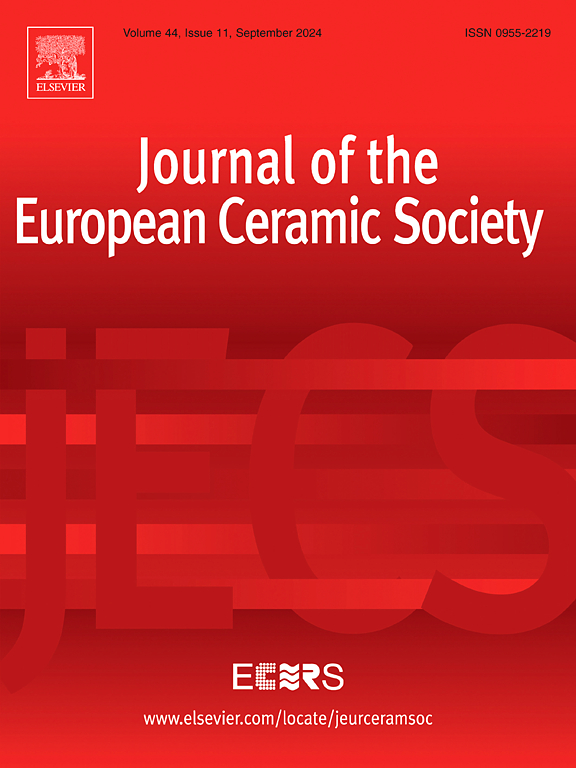2000 °C 以上 (Hf-Zr-Ta-Nb)C 涂层的长期性能优化:元素、成分和烧蚀特性
IF 5.8
2区 材料科学
Q1 MATERIALS SCIENCE, CERAMICS
Journal of The European Ceramic Society
Pub Date : 2025-03-27
DOI:10.1016/j.jeurceramsoc.2025.117403
引用次数: 0
摘要
对于碳基材料而言,高效、适当的多元素超高强度热保护涂层的成分设计具有巨大的需求和发展前景。基于等离子喷涂的(Hf-Zr-Ta-Nb)C 保护涂层体系,通过数据收集、机理分析、成分优化和实验验证等几个步骤,阐明了其协同效应。结果表明,(Hf0.25Zr0.25Ta0.25Nb0.25)C 涂层的保护能力不足(2000 °C,120 秒),这是由于高熔点相与低熔点相的含量比例相似。Ta 或 Nb 相对含量的下降有效改善了烧蚀性能,这归因于保留更多的 (Hf, Zr)O2 骨架相的支撑作用。在进一步筛选出适当的 Hf、Zr、Ta 和 Nb 元素组成后,(Hf0.45Zr0.45Nb0.1)C 保护体系得到了优化和逐步验证,并以近乎零的线性烧蚀率令人欣喜地显示出长期烧蚀特性(2000 °C,> 300 s)。本文章由计算机程序翻译,如有差异,请以英文原文为准。
Long-term performance optimization on (Hf-Zr-Ta-Nb)C coatings above 2000 °C: Element, composition and ablation property
Efficient and appropriate composition design of multi-elemental UHTCs for extremely thermal protection is in great demand and promising for carbon-based materials. Based on (Hf-Zr-Ta-Nb)C protective coating system via plasma spraying, the synergistic effects were clarified through several steps: data collection, mechanism analysis, composition optimization and experiment verification. Results showed that, (Hf0.25Zr0.25Ta0.25Nb0.25)C coating exhibited insufficient protective ability (2000 °C, < 120 s), due to the similar content ratio of high-melting-point and low-melting-point phases. The decline of Ta or Nb relative content effectively improved ablation property, attributed to the supporting effect of more retained (Hf, Zr)O2 skeleton phases. After further screening for the proper composition of Hf, Zr, Ta and Nb elements, the (Hf0.45Zr0.45Nb0.1)C protective system was optimized and verified step by step, which delightfully showed long-term ablation property (2000 °C, > 300 s) with nearly zero linear ablation rate.
求助全文
通过发布文献求助,成功后即可免费获取论文全文。
去求助
来源期刊

Journal of The European Ceramic Society
工程技术-材料科学:硅酸盐
CiteScore
10.70
自引率
12.30%
发文量
863
审稿时长
35 days
期刊介绍:
The Journal of the European Ceramic Society publishes the results of original research and reviews relating to ceramic materials. Papers of either an experimental or theoretical character will be welcomed on a fully international basis. The emphasis is on novel generic science concerning the relationships between processing, microstructure and properties of polycrystalline ceramics consolidated at high temperature. Papers may relate to any of the conventional categories of ceramic: structural, functional, traditional or composite. The central objective is to sustain a high standard of research quality by means of appropriate reviewing procedures.
 求助内容:
求助内容: 应助结果提醒方式:
应助结果提醒方式:


